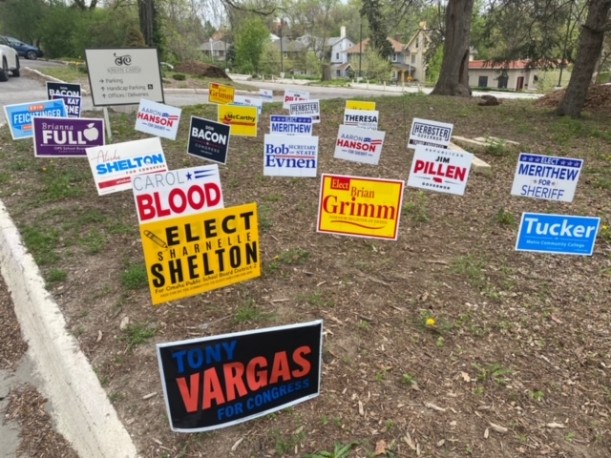Reading Today’s Messages, Messengers

A garden of campaign signs sprouts outside a polling place near Joslyn Castle in Omaha. (Courtesy of James D. Fogarty)
Poet Maya Angelou once wrote, “When someone shows you who they are, believe them the first time.” Even as an ardent believer in the hope of second chances and the power of personal redemption, her words are worth remembering.
Bob Dylan once sang, ”You don’t need a weatherman to know which way the wind blows.” Actually, all you need is a flag, as in a recent cause celebre that should concern anyone who believes in the credibility and impartiality of the nation’s highest court.
Flag flying is part of a larger cultural trend we use to send messages about who we are: in print, on clothing and affixed to car bumpers. I suppose that long arc began nearly a century ago when Levi’s put its name on a red label on the outside of its jeans. We moved to “I Like Ike” political pins, then to peace symbol tie-dyed T-shirts, “Baby on Board” bumper stickers and Nebraska sports jerseys to flags, waving today in stunning varieties.
When Husker football visited the University of California-Los Angeles in 1988, I clearly saw how much at least sports gear messaging had grown. Like hundreds of Nebraskans living in Los Angeles, I showed up at the Rose Bowl for the game and was astounded at the amount and diversity of Husker paraphernalia, from flags to hoodies to blazers to campers with Nebraska plates decked out in Go Big Red wrapping.
Today, though, we’re wondering about more than clothes tags or team names. Now we’re wondering about serious messages with potentially serious consequences.
After a U.S. flag in Supreme Court Justice Samuel Alito’s yard was flown upside down, a practice found among 2020 election deniers and Jan. 6 participants, and an “Appeal to Heaven” flag, a favorite among other extremists on the right, showed up at his New Jersey beach house, questions followed. And although explanations from Alito (his wife flew the upended Old Glory in response to a neighborhood dispute) and others (the “Appeal to Heaven” flag is commonly flown throughout New England), the general reaction was that most people believed him the first time.
Still, even in a nation awash in constant messaging, do we believe the words we read on fenders and in back windows, the stitching on chino back pockets and above baseball cap bills, the ideas unfurling on flagpoles and shining on lapel pins, the candidates’ names planted on yard signs and screaming from billboards? If we do, are these messages part of the public discourse or are they simply shout-outs, neither asking nor equipped for a response? Does a T-shirt with a message make me civically engaged? Or, more important, civically informed?
Sports fans have always loved to “represent.” Political persuasion and messaging, however, have exploded, far beyond a time when a button for your candidate above a chest pocket was considered de rigueur. Now we follow pickup trucks with tailgates fully emblazoned or entire rear windows of vehicles covered in slogans and other clamorings for a candidate or a cause.
Like most communication today, the tone of some of these public displays of political support has decidedly coarsened, such as “Let’s Go Brandon” or its earthier origin, which shows up from time to time. These and others such as “He Lost. Get Over It,” require no one to consult the Weather Channel as to which direction that political breeze is blowing.
As a working journalist for most of the last four decades — even one who writes commentary, I’m happy to report that my vehicle is bumper sticker-free. My yard is flag-free. My lapels are button-free. That’s because the newspapers frown (or they should) on public political displays including the aforementioned methods of messaging. I can sport a Husker shirt, whenever or wherever … well, maybe not in the press box at a Husker game. Family members are exempt from these ethical considerations, so when a yard sign for a political candidate shows up, a discussion ensues.
I have voted in every general and primary election for more than five decades at polling places that look like a journalist’s front yard should, too.
We live in a world filled with millions of messages, memes and more information than anyone could ever imagine, let alone digest and decipher. Maya Angelou cautioned that when the messengers show us who they are — social media posts, bumper stickers, flying flags — we should believe them. Bob Dylan told us not simply to believe them, but to recognize they show us where we’re headed.
We ignore them at our own peril.
This story was published by Nebraska Examiner, an editorially independent newsroom providing a hard-hitting, daily flow of news. Read the original article: https://nebraskaexaminer.com/2024/06/03/reading-todays-messages-messengers/
Opinions expressed by columnists in The Daily Record are not necessarily those of its management or staff, and do not constitute an endorsement or recommendation. Any errors or omissions should be called to our attention so that they may be corrected. Contact us at news@omahadailyrecord.com.
Category:
User login
Omaha Daily Record
The Daily Record
222 South 72nd Street, Suite 302
Omaha, Nebraska
68114
United States
Tele (402) 345-1303
Fax (402) 345-2351




